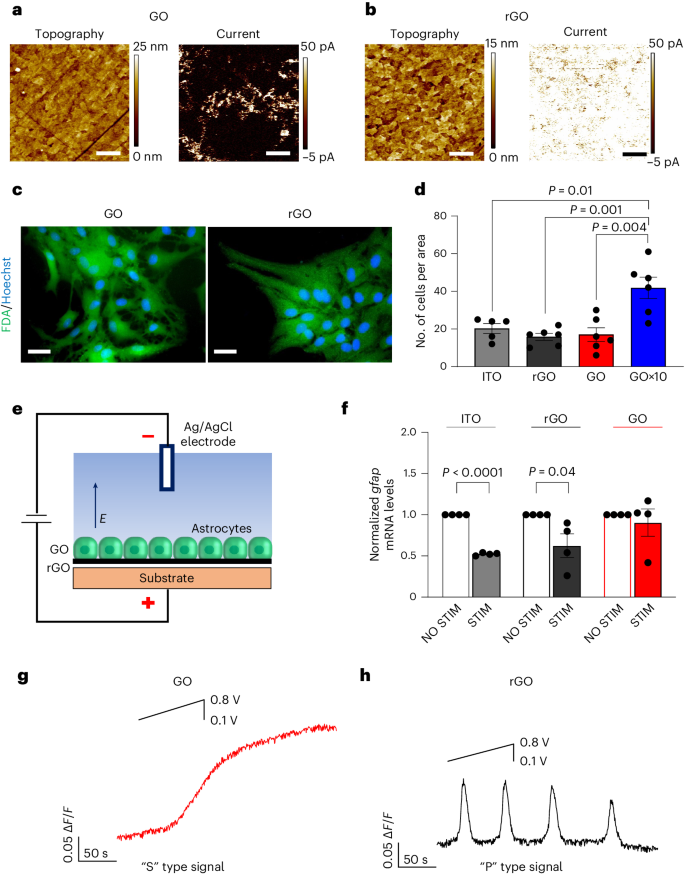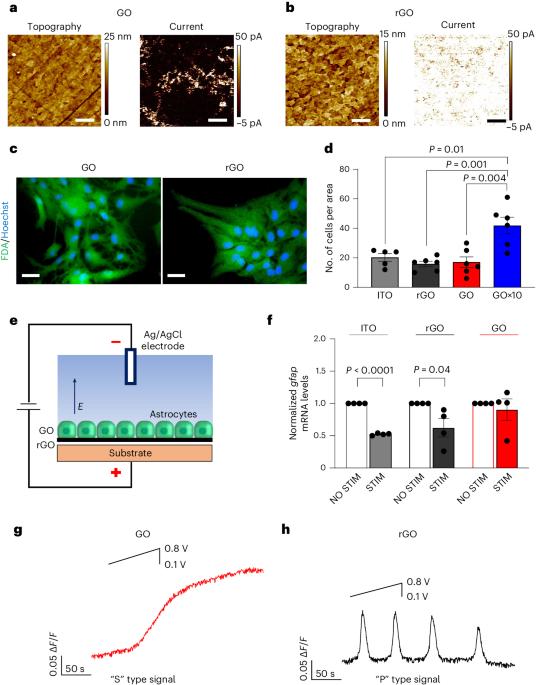氧化石墨烯电极可对大脑星形胶质细胞中不同的钙信号进行电刺激
IF 38.1
1区 材料科学
Q1 MATERIALS SCIENCE, MULTIDISCIPLINARY
引用次数: 0
摘要
星形胶质细胞负责通过钙信号维持体内平衡和认知功能,而这一过程在脑部疾病中会发生改变。目前的生物电子工具是为研究神经元而设计的,并不适合控制星形胶质细胞中的钙信号。在这里,我们发现,使用涂有氧化石墨烯和还原氧化石墨烯的电极对星形胶质细胞进行电刺激,可分别诱发由外部钙离子流入介导的缓慢钙离子反应和完全由细胞内钙离子释放引起的急剧钙离子反应。我们的研究结果表明,基底的不同电导率会影响细胞-电解质或细胞-材料界面的电场,从而有利于体外和体内的不同信号事件。膜片钳、电压敏感染料和钙成像数据都支持所提出的模型。总之,我们为神经科学和生物电子医学领域的直接研究提供了一种简单的工具,可以选择性地控制大脑星形胶质细胞中不同的钙信号。本文章由计算机程序翻译,如有差异,请以英文原文为准。


Graphene oxide electrodes enable electrical stimulation of distinct calcium signalling in brain astrocytes
Astrocytes are responsible for maintaining homoeostasis and cognitive functions through calcium signalling, a process that is altered in brain diseases. Current bioelectronic tools are designed to study neurons and are not suitable for controlling calcium signals in astrocytes. Here, we show that electrical stimulation of astrocytes using electrodes coated with graphene oxide and reduced graphene oxide induces respectively a slow response to calcium, mediated by external calcium influx, and a sharp one, exclusively due to calcium release from intracellular stores. Our results suggest that the different conductivities of the substrate influence the electric field at the cell–electrolyte or cell–material interfaces, favouring different signalling events in vitro and ex vivo. Patch-clamp, voltage-sensitive dye and calcium imaging data support the proposed model. In summary, we provide evidence of a simple tool to selectively control distinct calcium signals in brain astrocytes for straightforward investigations in neuroscience and bioelectronic medicine. Electrical stimulation of astrocytes using electrodes coated with graphene oxide and reduced graphene oxide can be used to trigger specific calcium signals.
求助全文
通过发布文献求助,成功后即可免费获取论文全文。
去求助
来源期刊

Nature nanotechnology
工程技术-材料科学:综合
CiteScore
59.70
自引率
0.80%
发文量
196
审稿时长
4-8 weeks
期刊介绍:
Nature Nanotechnology is a prestigious journal that publishes high-quality papers in various areas of nanoscience and nanotechnology. The journal focuses on the design, characterization, and production of structures, devices, and systems that manipulate and control materials at atomic, molecular, and macromolecular scales. It encompasses both bottom-up and top-down approaches, as well as their combinations.
Furthermore, Nature Nanotechnology fosters the exchange of ideas among researchers from diverse disciplines such as chemistry, physics, material science, biomedical research, engineering, and more. It promotes collaboration at the forefront of this multidisciplinary field. The journal covers a wide range of topics, from fundamental research in physics, chemistry, and biology, including computational work and simulations, to the development of innovative devices and technologies for various industrial sectors such as information technology, medicine, manufacturing, high-performance materials, energy, and environmental technologies. It includes coverage of organic, inorganic, and hybrid materials.
 求助内容:
求助内容: 应助结果提醒方式:
应助结果提醒方式:


